Winter Birding in Izumi
By Mark Brazil | Jan 31, 2022
Izumi: Japan’s Southern Crane Paradise
Introduction
Cranes are fascinating, elegant, and dramatic, so it is hardly surprising that they are high on the list of species in-bound birders aim to see when they visit Japan.
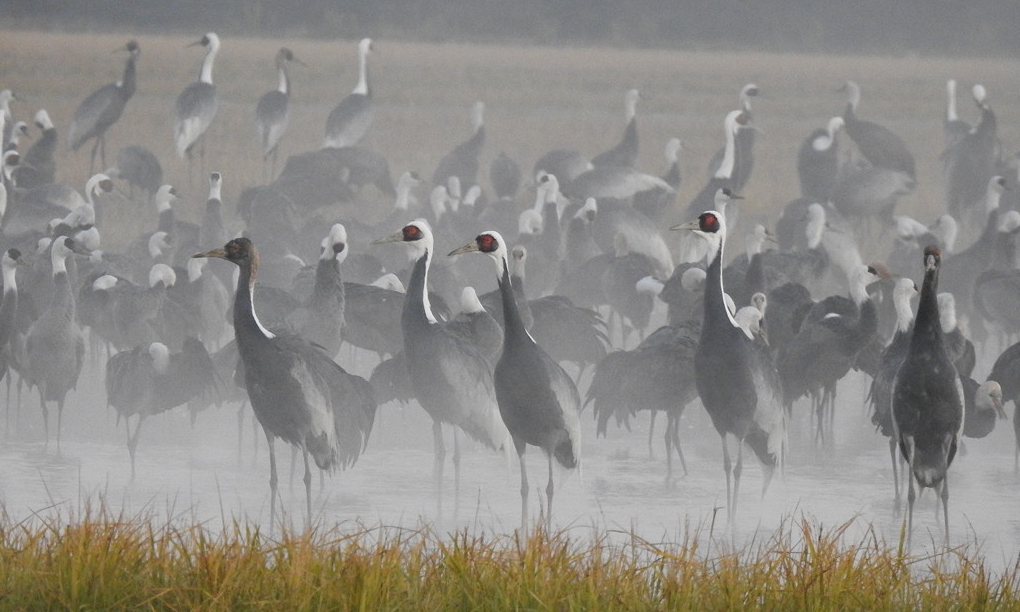
White-naped Cranes on a rare misty morning at dawn © Mark Brazil
The Kushiro Wetland area of southeast Hokkaidō is a major draw as it is home to the great majority of Japan’s Red-crowned Cranes in winter. Hordes of visiting birders and photographers flock to sites in Tsurui and Akan villages, to witness and watch the hordes of wintering cranes that visit there to roost and feed. Every photographer’s dream is to take images of displaying cranes, dancing and calling in falling snow against a backdrop of a snow-covered landscape.
A significant proportion of those visiting birders and photographers also visit the opposite end of the country, attracted to Izumi, in Kagoshima Prefecture Kyūshū, by its gathering of cranes. This extraordinary annual natural event is not to be missed. Here the landscape is on a smaller scale, low hills surround small-scale farms with tiny fields, the forested hillsides are largely covered with evergreen forest and, even in winter, camellia and sasanqua trees are in flower in suburban gardens. Kyūshū’s mild cool-temperate climate is a far cry, and a long way, from the sub-boreal atmosphere of east Hokkaidō.
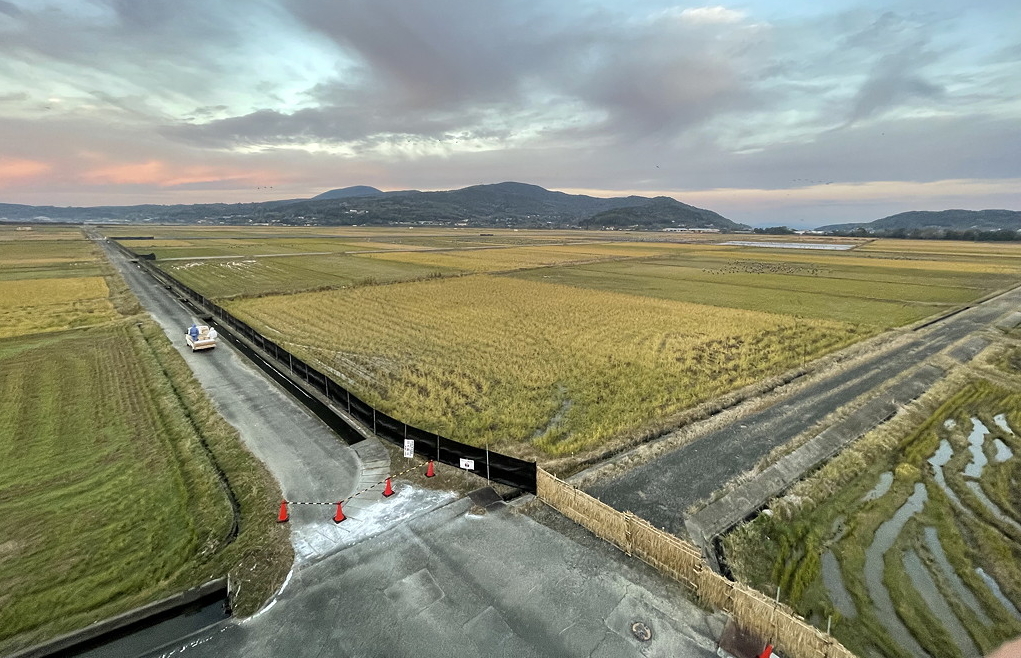
The view across Nish Kantaku from the rooftop of the Izumi Crane Observation Centre © Mark Brazil
I’ve been visiting this area for almost 40 years, my first visit to this landscape of narrow valleys with tiny rice fields and steep hillsides clad in forest, bamboo and forestry plantation was in February 1982, and I have returned many times since, witnessing first hand the steady increase in the wintering crane population to be found there.
Izumi is, for the uninitiated, a birding Mecca. Birdwatcher’s from around the world make winter pilgrimages to this area of Kyūshū, drawn by one of the largest gatherings of birds in Japan — the wintering hordes of Hooded Crane and White-naped Crane.
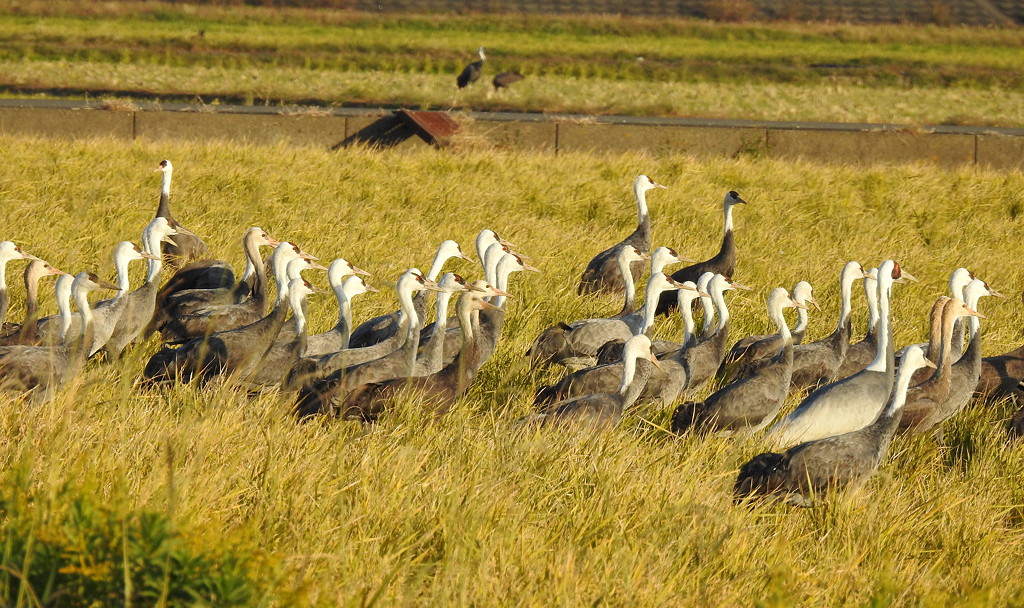
Hooded Cranes at Arasaki © Mark Brazil
Observing Japan’s Wintering Cranes at Izumi
Thousands of stately cranes of up to five species gather in the Izumi area on the fallow fields of the low-lying fertile farmland that has been reclaimed, generation-by-generation, from the southern part of Izumi Bay. It is here that they feed and sleep in safety during the winter months. They remain until lengthening days in late winter and early spring urge them to migrate back north to their breeding territories in northeast Asia.
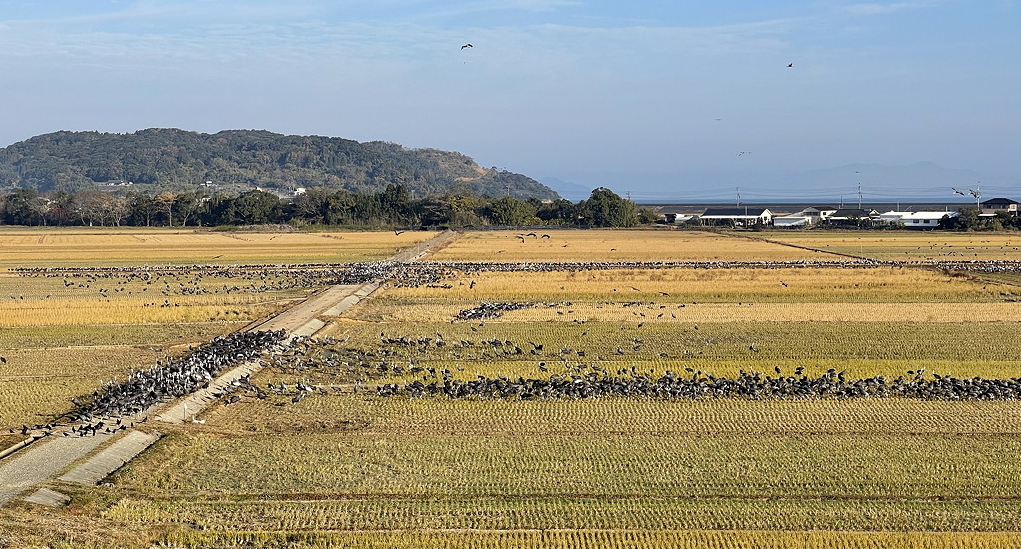
Cranes gather on fallow farmland during winter for safety in numbers and convenient access to food © Mark Brazil
In autumn, the young cranes fly south with their parents to Kyūshū, learning the migration route and the safe places to rest and forage along the way. They have one more chance to cement that learning during the family’s spring northbound migration; thereafter they must find their own way in the world, find their own partner, raise their own families, and teach their own young the way. Each winter watchers in Kyūshū await their return, counting the families that have succeeded.
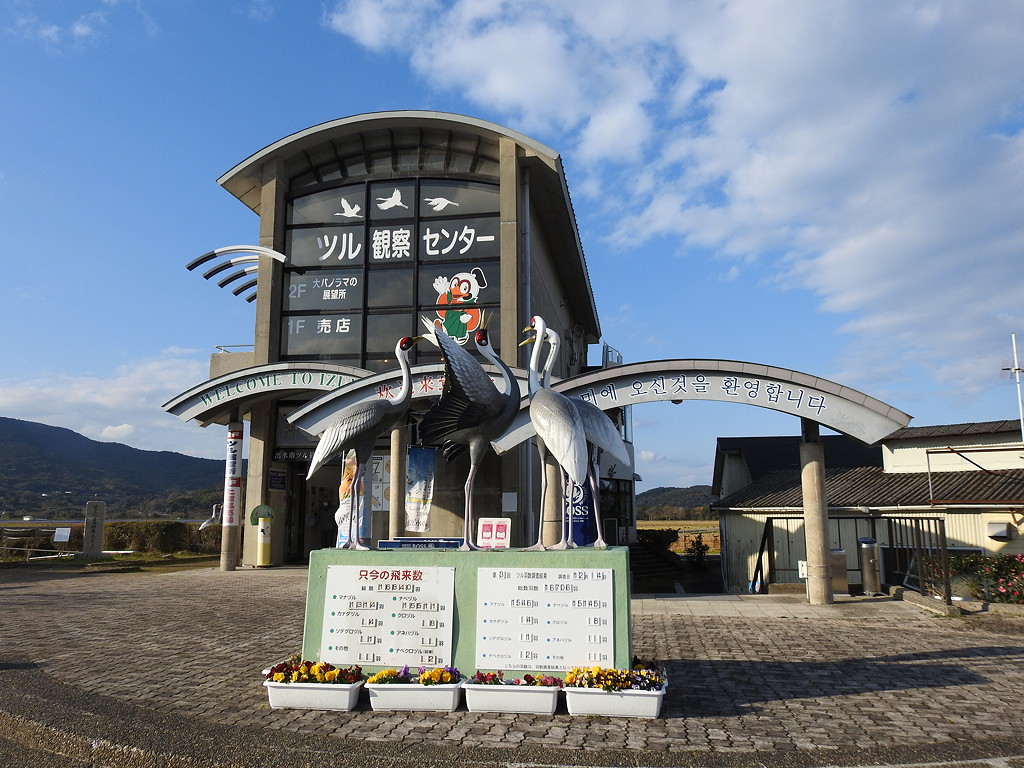
The Izumi Crane Observation Centre is the first place to head for crane watchers © Mark Brazil
Known to birdwatchers worldwide as Arasaki, the reclaimed land west of the broad Iwashita River is the first place to head. There, the Crane Observation Centre (32.10286, 130.27513), which is a mere ten kilometres or so from Izumi Station, overlooks the fields of Arasaki that play host to the larger part of the crane gathering.
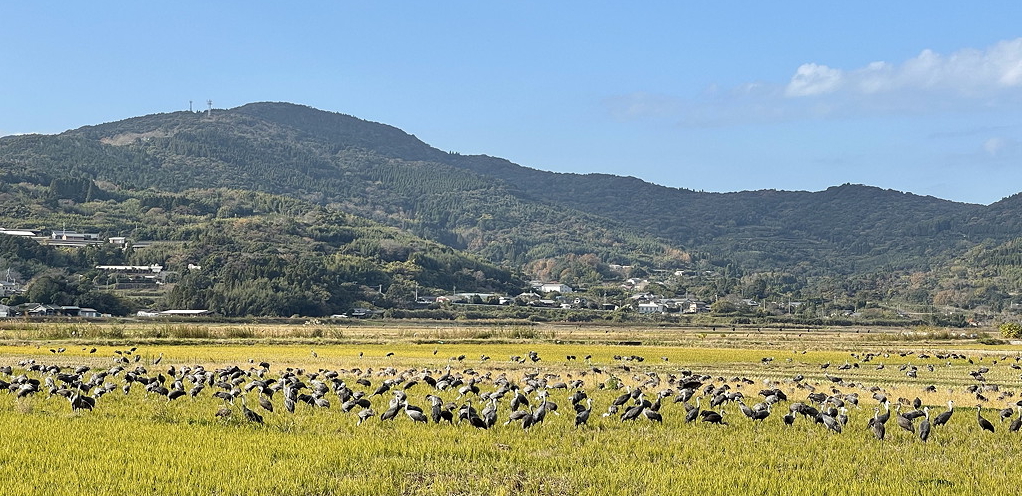
The fields of Arasaki are now world-famous for the winter gathering of cranes © Mark Brazil
The rooftop viewing deck provides the very best vantage point from which to watch the cranes in the early morning as they wake and begin to fly out to their feeding grounds. The cranes pack to together overnight, roosting in standing water in fields specially flooded for them.

Hooded Cranes set off to forage in small groups or families © Mark Brazil
At dawn, their bugling cries fill the air, making this as much an emotional soundscape as a tremendous sight. The dawn departure of birds from the crane roost is truly spectacular and is by far the greatest highlight of any visit to Izumi. It is worth repeating on several mornings, and over the years I have never tired of this sight.
A Crane’s Day on the Izumi Plain
The cranes pass the night-time hours at roost, standing on one leg (the other is tucked up into their belly feathers). The neck and head are looped and draped over the back between their folded wings. They begin calling before dawn, and their calling escalates as the day’s first light reaches them; the first individuals, pairs and families stretch awake then take off. At some time within an hour of dawn their exodus occurs. On some days they march out from the roost like an army, on some days they burst into massed flight, but on most mornings they leave in a steadily increasing stream of families and flocks. They spend their winter days foraging for food remaining after the autumnal harvest, or feasting on food put out specially for them.
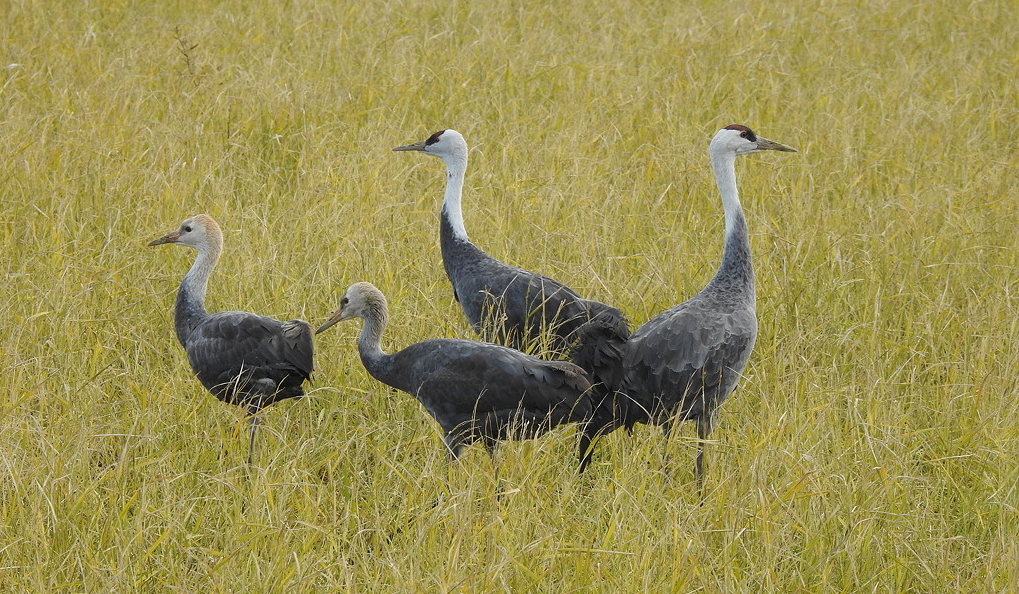
A Hooded Crane family with two brown-necked chicks © Mark Brazil
Within the flock, family units are most conspicuous, each pair alone, or with a single chick or, if they were supremely successful, two. Cranes habitually lay two eggs, but frequently lose one or both eggs or chicks to predators on their breeding grounds. Parent cranes are vigilant taking turns to stand watch over their youngsters as they feed. While some forage within a kilometre or so of their roost site, some fly out ten kilometres or more to find quiet, undisturbed fields away from the crowds. They pass the day mostly in feeding, spending some time also preening, then as the afternoon light wanes the cranes return once more to their roost site; families and flocks build up in numbers as the light fades, until wave after wave of calling birds homes in on the roost. Long after they have settled amongst the roosting throng their calls continue into the night.
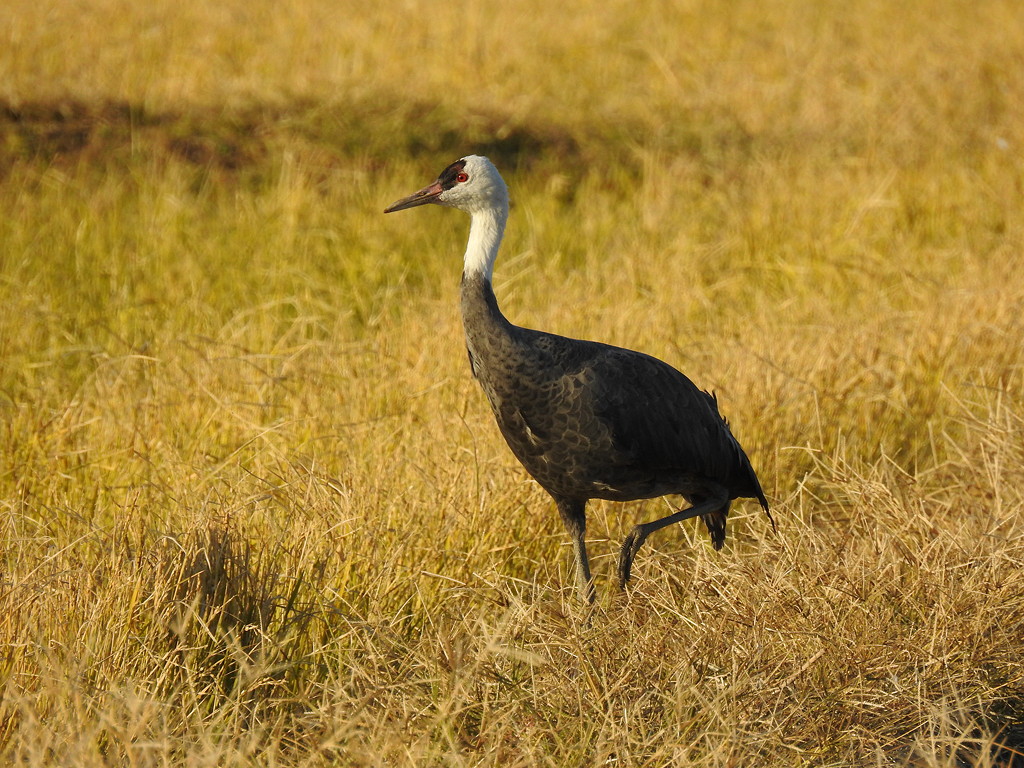
An adult Hooded Crane © Mark Brazil
The Cranes of Izumi and Where to Watch Them
The crane flock at Izumi consists almost entirely of two species. There are approximately 15,000 Hooded Cranes (90–100 cm tall with a wingspan of 160–180 cm), and 1,500–2,000 White-naped Cranes (120–153 cm tall with a wingspan of 200–210 cm).
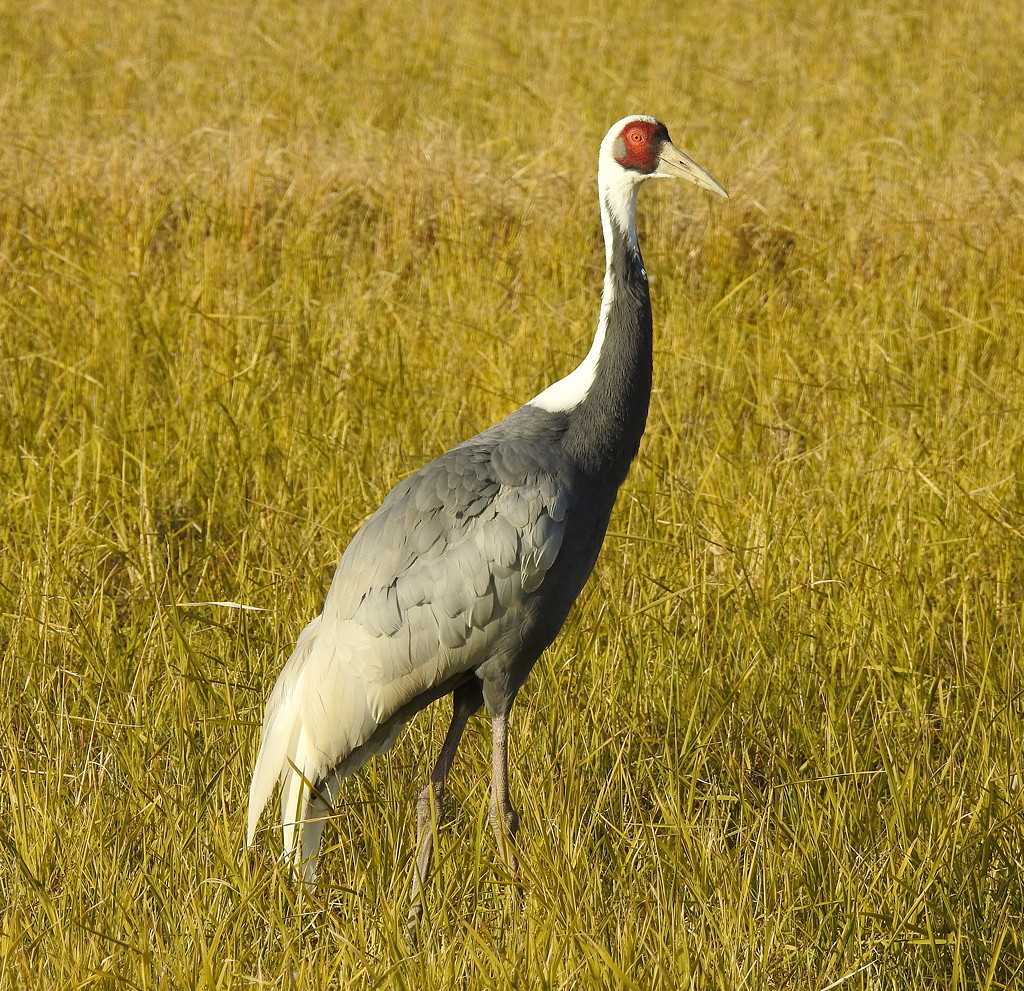
An adult White-naped Crane — the only Asian crane to have red cheeks © Mark Brazil
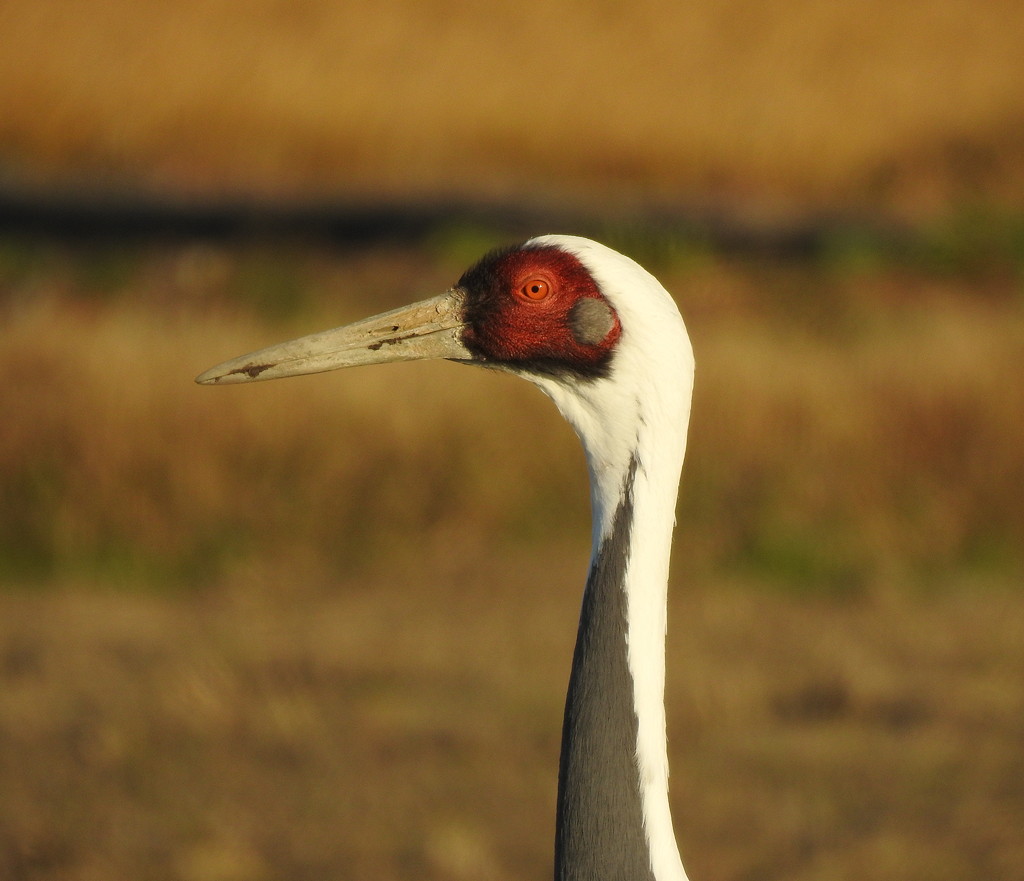
White-naped Crane portrait revealing the adult's orange eye and grey feathering covering its ear © Mark Brazil
Each winter, this huge magnetic flock attracts several Sandhill Cranes, as well as several Common Cranes. The Sandhill Crane is the typical crane of North America, while the Common Crane is so named because it is the common species in its native European and West Asian range. Even rarer species occasionally join the flock and these include the dainty, diminutive Demoiselle Crane and the exceedingly rare and stately Siberian Crane. Once every few decades, individual Red-crowned Cranes also reached the area.
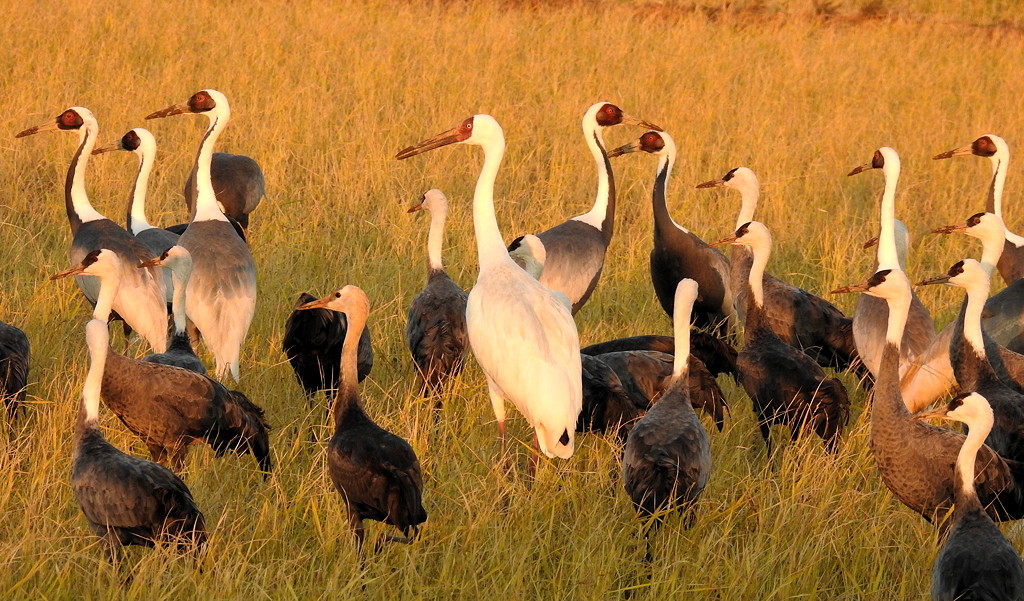
Siberian Crane, with White-naped and Hooded cranes, at Higashi Kantaku in December 2021 © Mark Brazil
This winter (2021/2022) the signboard in front of the Crane Observation Centre notes that during the census on 4 December 2021, 16,706 cranes were counted, a staggering 15,145 Hooded Cranes, 1,546 White-naped Cranes, with as many as eight Common, four Sandhill and the Siberian in residence.
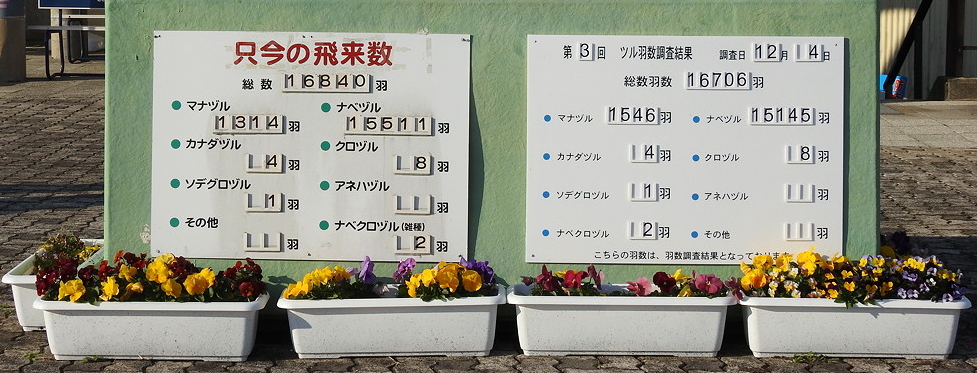
Each winter the numbers of cranes wintering at Izumi are posted outside the Crane Observation Centre and inside the Crane Park Museum © Mark Brazil
When I first visited in 1982 there were a mere 5,000 or so cranes in total, though that had risen to about 8,000 by 1987 when my A Birdwatcher’s Guide to Japan was published. Topping 10,000 birds (considered an auspicious number in Japan) seemed like a heady milestone, but now it seems possible that one day they may reach 20,000 birds.
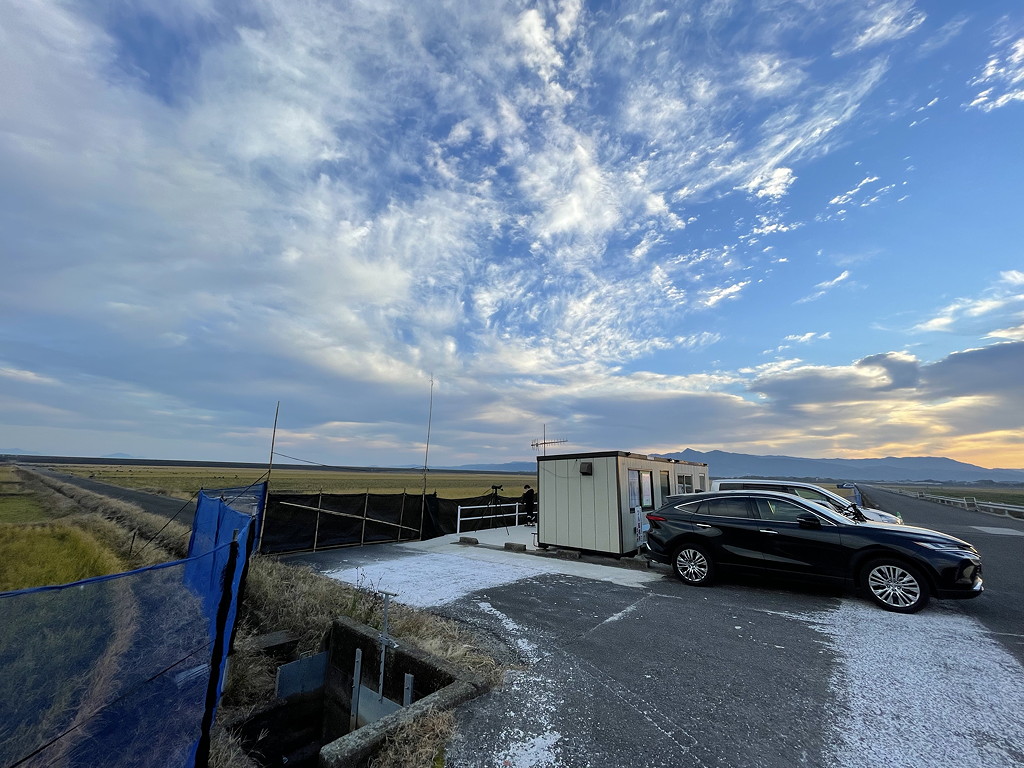
The Higashi Kantaku feeding area offers the best location from which to search for Sandhill Cranes within the crane flock © Mark Brazil
The first hour of light sees thousands of birds taking to the air, and the cacophony of sound is unbelievable. Many of them will fly eastwards across the river to join others on the area of reclaimed land there known as Higashi Kantaku (32.10425, 130.29374). This is another renowned area for crane watchers, especially as the Sandhill Cranes are typically in this area, Eurasian Spoonbills and even Black-faced Spoonbills are commonly sighted here too along with Common Shelduck.
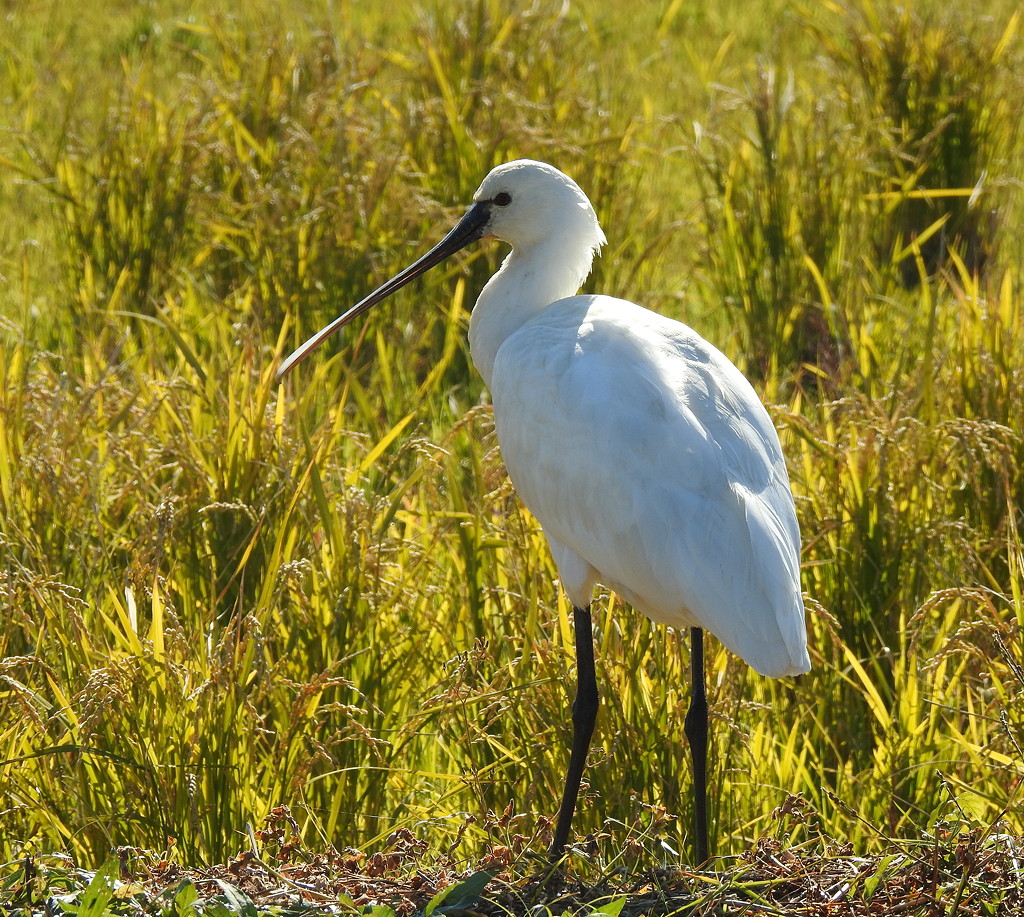
Small numbers of Eurasian Spoonbills are regular winter visitors to Izumi © Mark Brazil
The wintering crane flock includes individual adults intent on finding a mate for the breeding season ahead, pairs that have not yet reared young intent on rekindling their pair bond, and parents guarding their single or twin youngsters. It is hardly surprising then, that when they are not busy feeding they are very busy interacting. Individuals approaching too closely to a foraging family can expect to be bullied away by irate parents, in lunging attacks with their bills. Young cranes are readily distinguished in winter by brown feathering on their necks and heads and by their general lack of concern for everything around them except their parents — and food.
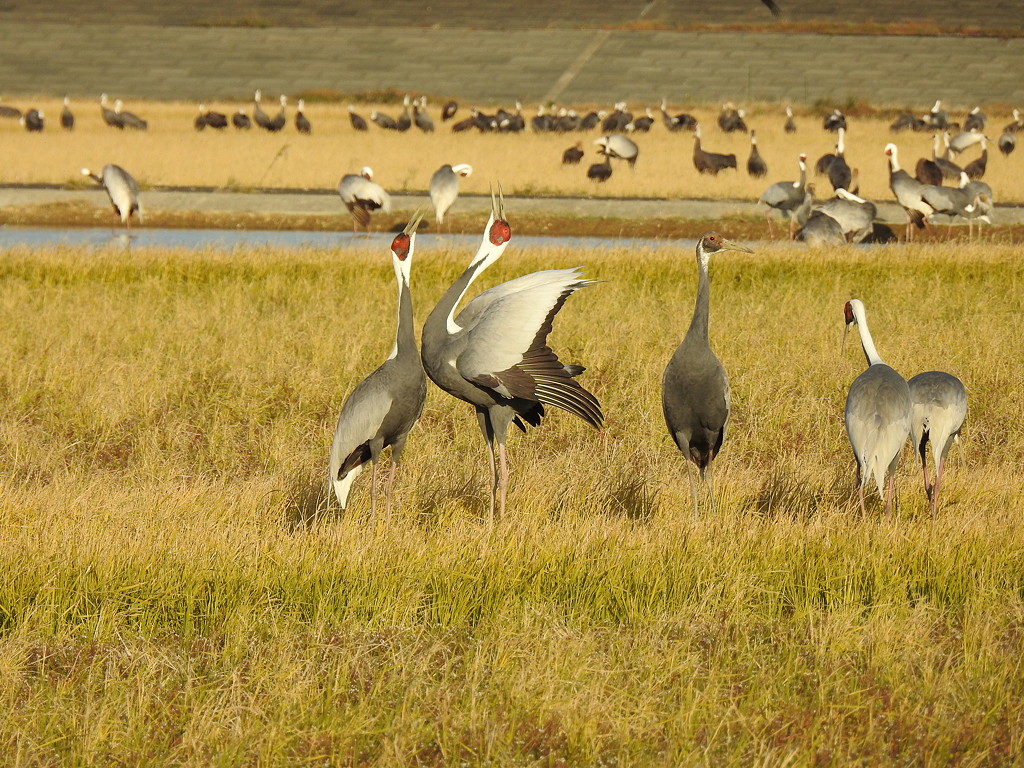
The White-naped Crane's display is brief, but spectacular © Mark Brazil
Tall males attempt to attract smaller females with their powerful calls combined with ‘come hither’ posturing. The White-naped Cranes are by far the most demonstrative, their displays are brief, yet delightful. Their subtly-shaded plumage in greys and whites is shown off at its best as they sky-point with their bills and flick their half-folded wings up and over their backs, their chic long white tertial feathers drooping down over their tail feathers and catching the breeze. As the pairs posture they call in a distinctive duet. Those are the highlight moments to watch and listen for.
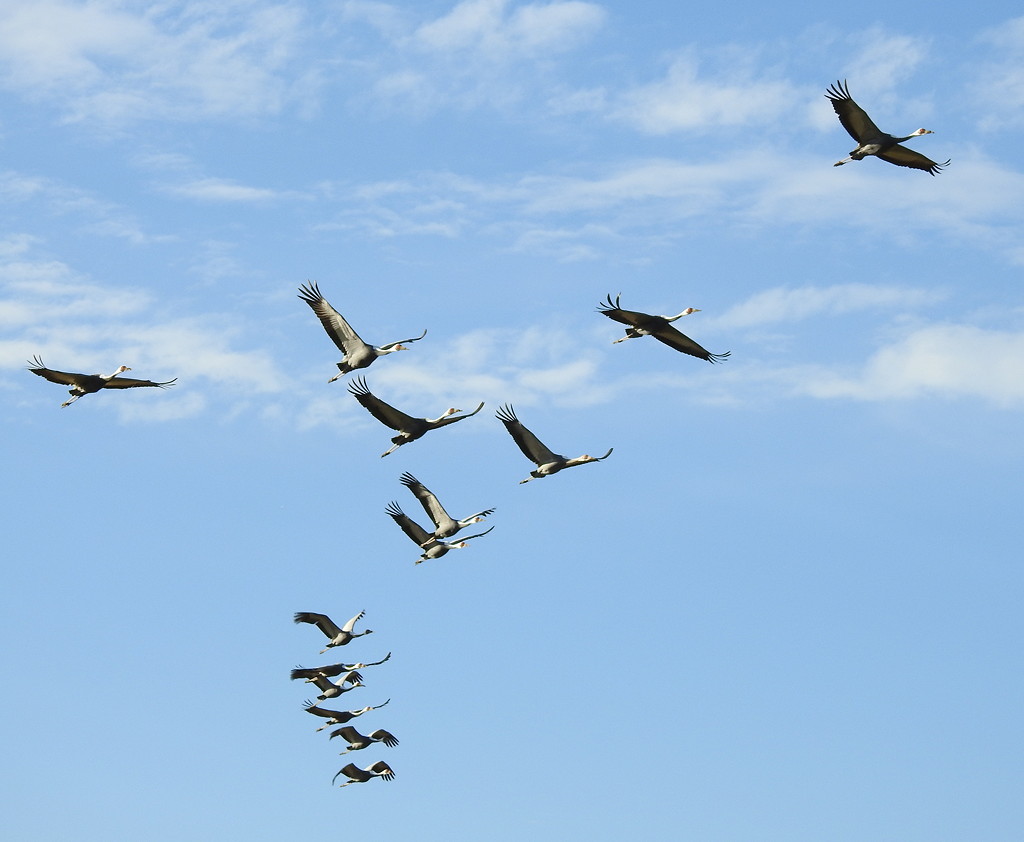
White-naped Cranes begin their migration back to their continental breeding grounds several weeks earlier in spring than Hooded Cranes © Mark Brazil
As winter wanes, courtship behaviour increases among the newly forming and re-establishing crane pairs. When hints of spring appear, during late February and early March, small, then large flocks begin their northward journey. They have a busy summer breeding season ahead and will not migrate again to Izumi until October or November.
On 18 November 2021, in a major accolade for Izumi City, the wintering habitat of cranes at Izumi was designated as a Wetland of International Importance under the international Ramsar Convention.
Birdwatching Beyond Cranes
Winter birdwatching at Izumi is not all about the cranes. The tree tops and telephone wires in the area commonly hold 100s, even 1,000s, of Eastern Rooks. This migratory member of the crow family also arrives to winter in the Izumi area, coming from as yet unknown breeding grounds somewhere on the continent.
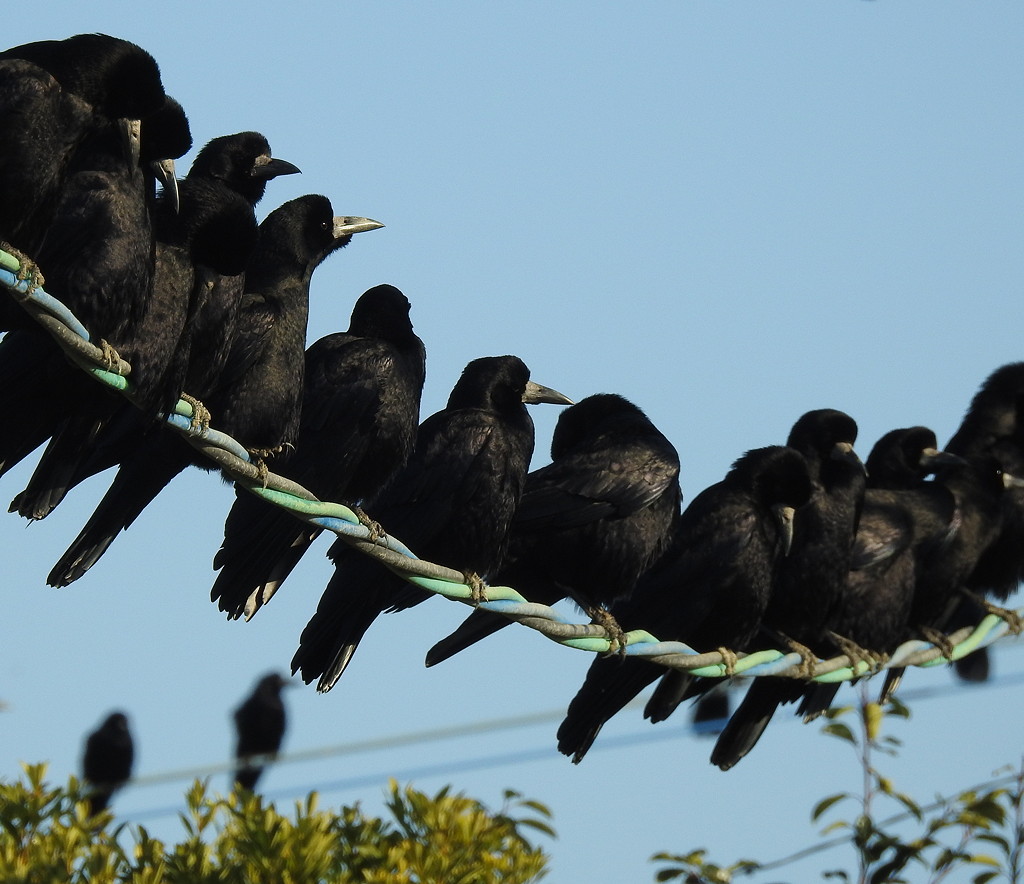
Eastern Rooks, a scarce or even rare bird in most of Japan, are common in winter on the Izumi Plain © Mark Brazil
There may also be White-cheeked Starlings and Russet Sparrows on the wires around the crane centre, while jaunty colourful Daurian Redstarts are often to be found nearby. It is worth scanning through every flock of starlings as the Common Starling (a scarce bird in Japan) may sometimes be found here, as may Red-billed Starling (a winter rarity).
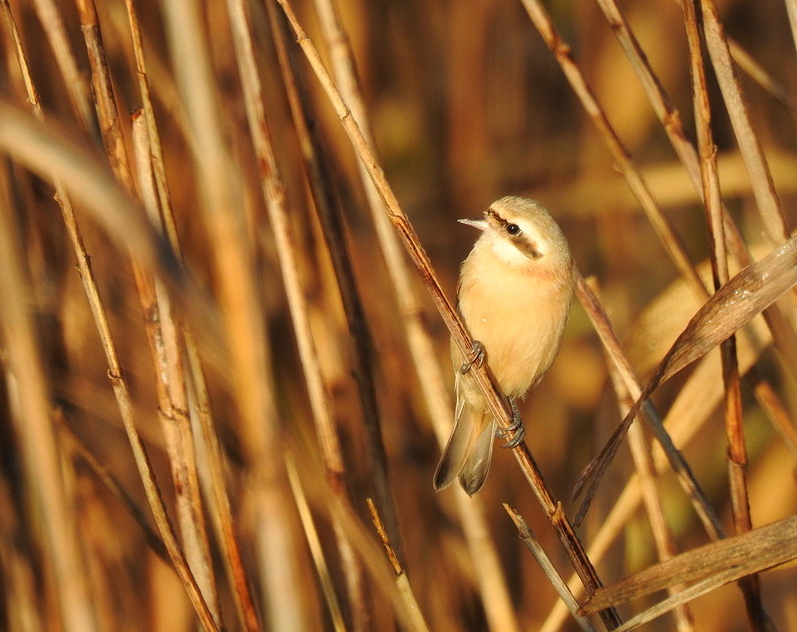
Chinese Penduline Tit is an uncommon winter visitor to seedbeds in the Izumi area © Mark Brazil
The reed beds along the rivers east and west of the crane site harbour many small birds, mostly various buntings, but sometimes crakes and rails. An area favoured by Chinese Penduline Tit is in the reeds alongside the Kouchi River (32.11596, 130.26627). The trees near the northwest corner of Warabi Island (32.12611, 130.26440; 2–3 kilometres northwest of the crane centre) host a busy Grey Heron colony, to which the breeding birds return in January and February and entertain watchers as they carry sticks back to their previous year’s nests and display atop them.
Exploring different habitats will add considerably to the list of species found during any visit. I recommend searching the various rivers for wintering duck (Mallard, Eastern Spotbilled Duck, Eurasian Wigeon, Northern Pintail, Eurasian Teal and Northern Shoveler mostly), the exposed mudflats at low tide for any shorebirds such as Dunlin, and the wet fields of Nishi Kantaku and Higashi Kantaku for wintering Northern Lapwing. I have even seen Grey-headed Lapwing and Long-billed Dowitcher here, though they are very scarce visitors.
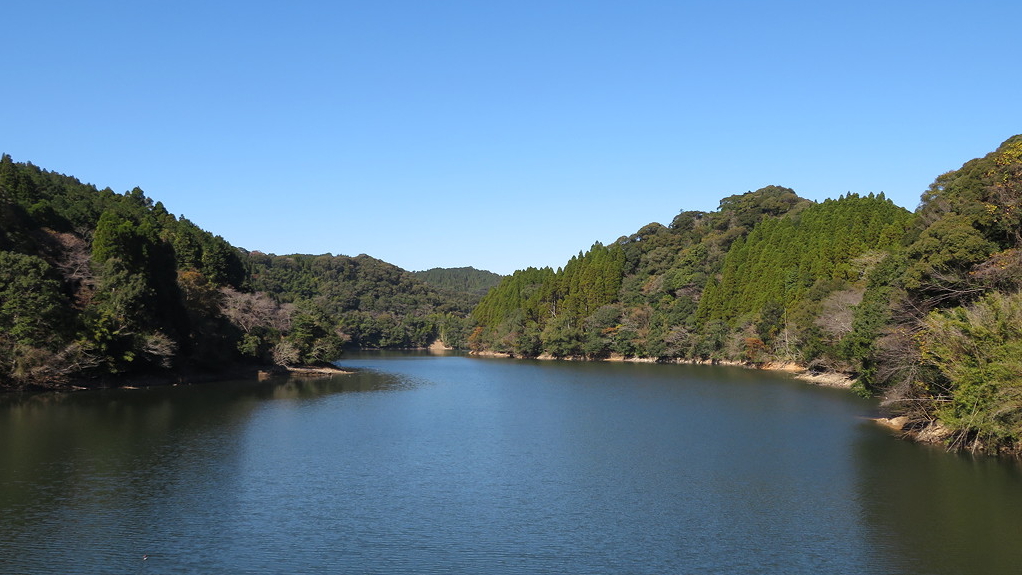
Kogawa Reservoir offers very different habitats for winter birds © Mark Brazil
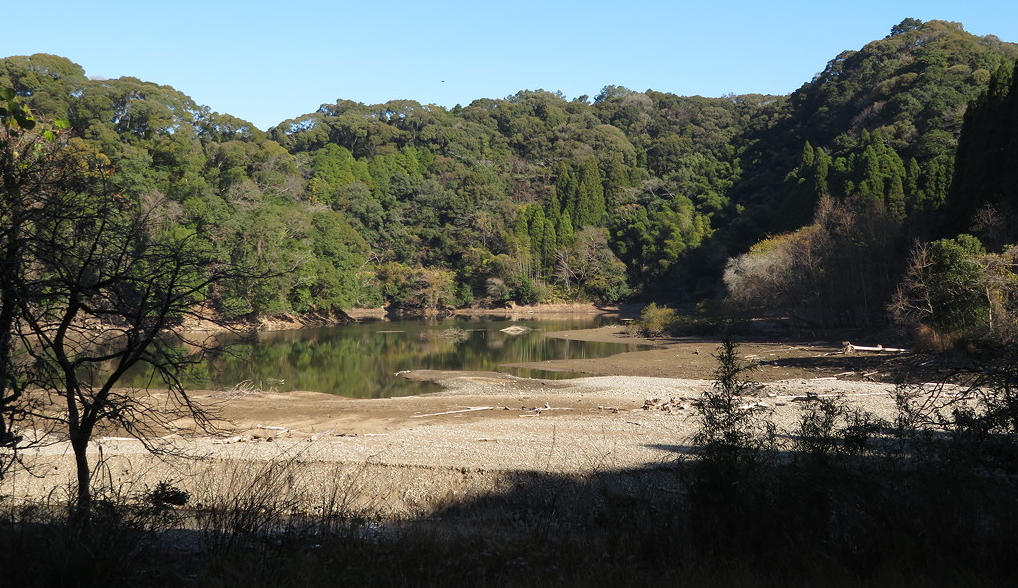
Kogawa Reservoir © Mark Brazil
To the southeast of Izumi lies Kogawa Dam (32.06470, 130.41205) and its associated reservoir. The mixed evergreen forests surrounding this body of water hold common forest birds such Japanese Pygmy Woodpecker, Japanese Tit, Varied Tit, Masked Bunting, Meadow Bunting and Elegant Bunting, and even White-bellied Green Pigeon and Ryukyu Minivet may be seen. On the reservoir itself in winter watch for small flocks of waterfowl, often including Eurasian Wigeon, Common Pochard, and Mandarin Duck.
The cranes are without doubt Izumi’s key attraction, but in winter the surrounding area is rich in other avian species too. I described it in my book A Birdwatcher’s Guide to Japan as deserving “wider recognition as one of the finest areas for winter birding in Japan”, and ranked it in my top three favourite sites for birding in Japan. Four decades later both statements remain true.
To visit Izumi for the cranes without sparing time to enjoy looking for a wide range of other species in the area, from Black-faced Spoonbill to Ryukyu Minivet, is to miss a trick.
Historical and Cultural Bonuses while visiting Izumi
For those with extra time to spare, or who wish for a brief break from the sights and sounds of cranes during the middle of the day there are yet more aspects of Izumi to explore as the city also has historical and cultural features of note. You may enjoy reading my article about Izumi's attractions published by Voyapon.
Among these, Hakozaki Hachiman Jinja, Tōkō-zan, Izumi Bukeyashiki and Crane Park Izumi are great options.
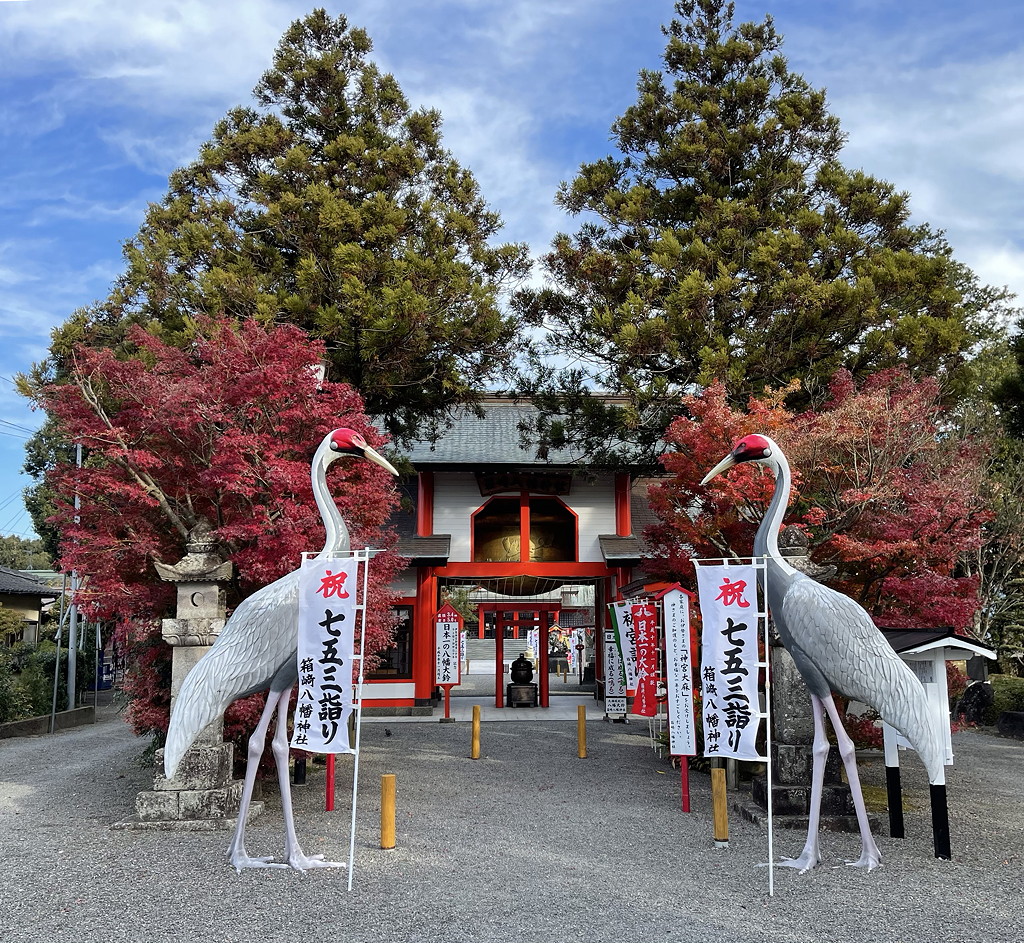
Izumi Hakozaki Hachiman Shrine is flanked by White-naped Crane statuary and houses a giant bell © Mark Brazil
Hakozaki Hachiman Jinja (32.08566, 130.34161) is a rather special Shinto shrine as it reflects an appreciation of cranes and their symbolic and mythological representation of long life.
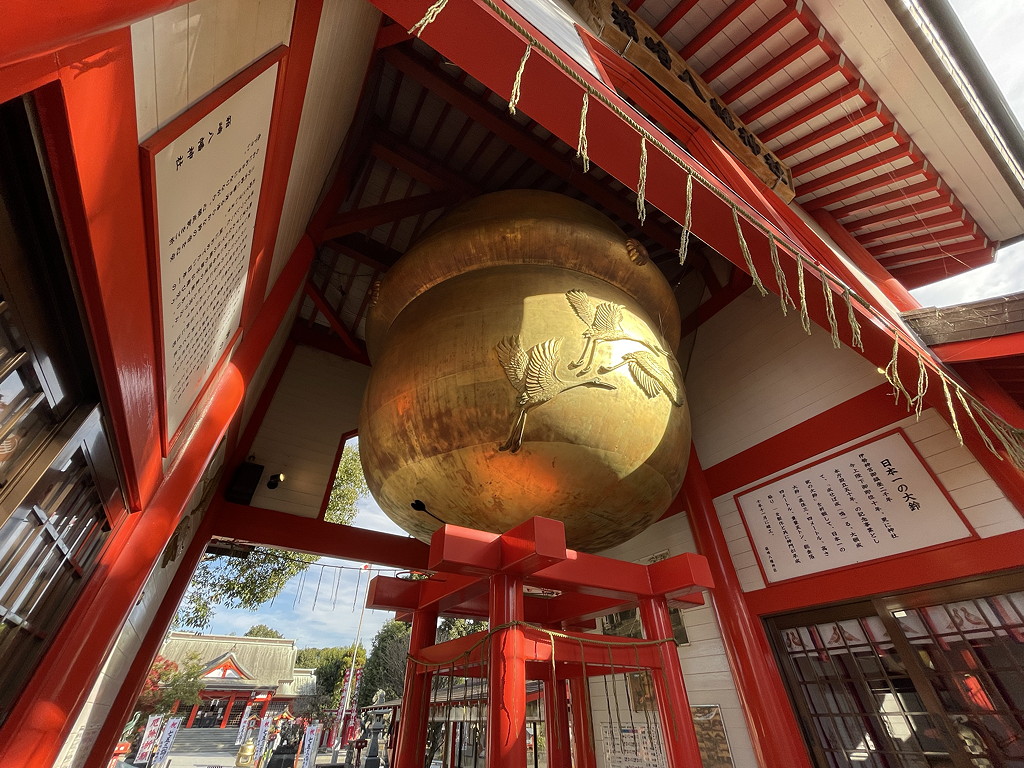
The Giant Bell, Japan's largest shrine bell, at Hakozaki Hachiman Shrine © Mark Brazil
Statues of cranes line the approach to the shrine, but the key feature of the shrine is the giant bell that hangs in the entrance building. Measuring 3.4 m from top to bottom and weighing a staggering 5.0 tons it is Japan’s largest shrine bell. It is doubly impressive because this giant bell is not only enormous, but it is also embossed with depictions of cranes in flight!
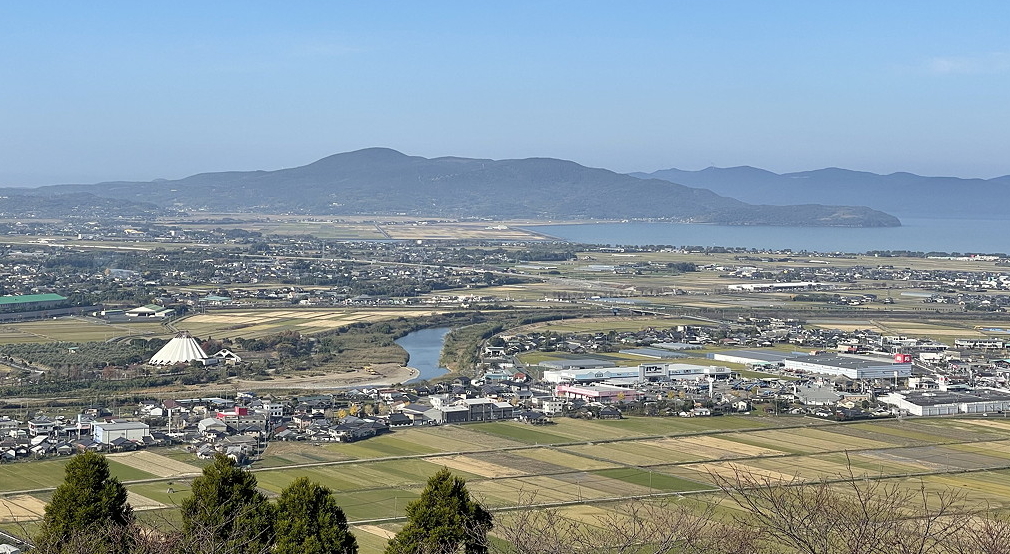
The view from Tōkō-zan looking out across the Izumi Plain with the distinctive Crane Park Museum visible in the lower left © Mark Brazil
To the east of Izumi City stands a low mountain, Tōkō-zan (32.09813, 130.3602765799192), with a wooded park and a viewing tower. This site offers a tremendous panoramic view across the city to Izumi Bay, and the reclaimed land where the cranes winter, and also holds common wintering woodland birds.
Izumi’s historical quarter, known as Bukeyashiki (32.07539, 130.35807), with its various samurai residences is well-worth strolling around. The houses offer a fascinating insight into life in Japan 200–400 years ago, and the gardens in the neighbourhood often host common wintering birds such as Japanese Pygmy Woodpecker, Dusky Thrush, Pale Thrush, Daurian Redstart, Japanese White-eye and Hawfinch.
 © Mark Brazil DSCN9852.jpg)
Japanese drain covers are an art form! Here a samurai archer kneels to shoot in Izumi Bukeyashiki © Mark Brazil
Save time and avoid the baffling Izumi-Fumoto Historical Museum located at the site as it is designed only for readers of Japanese and is impenetrable to non-readers. Instead, allow yourself an hour to wander around this fascinating quarter of this small city and step inside the Saisho-tei and Takezoe Houses for a closer look at their astonishingly simple interiors.
Crane Park Izumi (32.09805, 130.34354) includes an impressive museum with fine educational displays about cranes in Japan and around the world.
Izumi: Access and Accommodation
Kyūshū is well-served for air-travellers, with main airports at Fukuoka, Kumamoto and Kagoshima, with regular flights from several of Japan’s major cities. From Tōkyō’s Haneda Airport, for example, it takes just two hours to Kagoshima Airport. Shinkansen (bullet trains) run between Kagoshima City and Fukuoka City, stopping on the way at Izumi and Kumamoto. Izumi is a mere 25 min from Kagoshima, 30 mins from Kumamoto and 1 hr 30 min from Fukuoka, with one or two trains an hour stopping at Izumi Station. Izumi can also be accessed directly by Nangoku Kōtsū bus from Kagoshima Airport to Izumi Station in 75 minutes, and a Crane Sightseeing Taxi system operates between Izumi Station and the Crane Observation Centre in winter. Many visitors will opt to rent a car at one of the airports to have complete flexibility of travel.
There are several hotels in Izumi City and various minshuku and other forms of accommodation. Tsurumitei, the family-run minshuku situated right beside the Crane Observation Centre, is perhaps the most famous, but Hotel Wing International Izumi, a simple business hotel with simple hearty breakfast fare, situated conveniently less than five minutes walk from Izumi Station, is also popular. Hotel Sengokutei, located beside Rt 328 and within walking distance of the museum at Crane Park Izumi is rather more spacious and luxurious with excellent food, though of course in a higher price bracket.
A wide array of eateries is available in Izumi; however, most birdwatchers and photographers will opt to have breakfast and dinner at their accommodation and lunch from a local convenience store, so as to take full advantage of the short winter days.
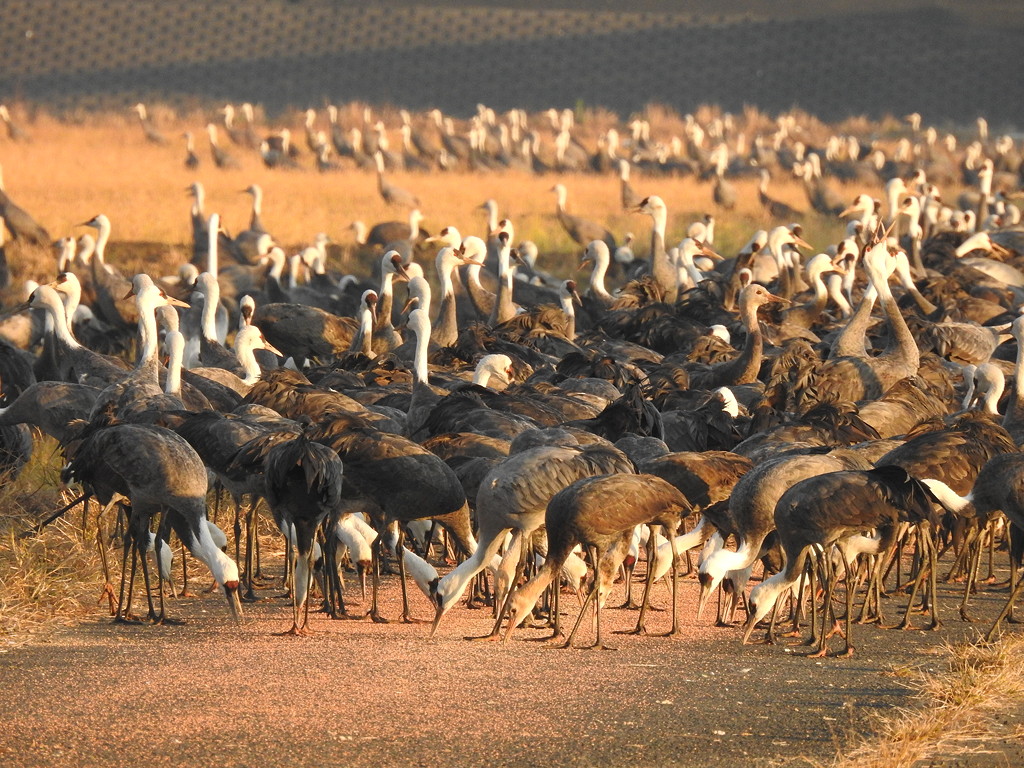
Hooded Cranes crowd together at feeding time © Mark Brazil
Conclusion
A winter visit to Izumi, for the pleasure of watching and photographing the huge gathering of 17,000 or more Hooded, White-naped, Sandhill and Common cranes, is not to be missed. Almost every winter a rarity appears adding spice to the experience. On my very first visit it was a Demoiselle Crane, this winter it was an adult Siberian Crane, and in between I have seen several of the former and of the latter, and once even a Red-crowned Crane — all seven of Japan’s cranes.
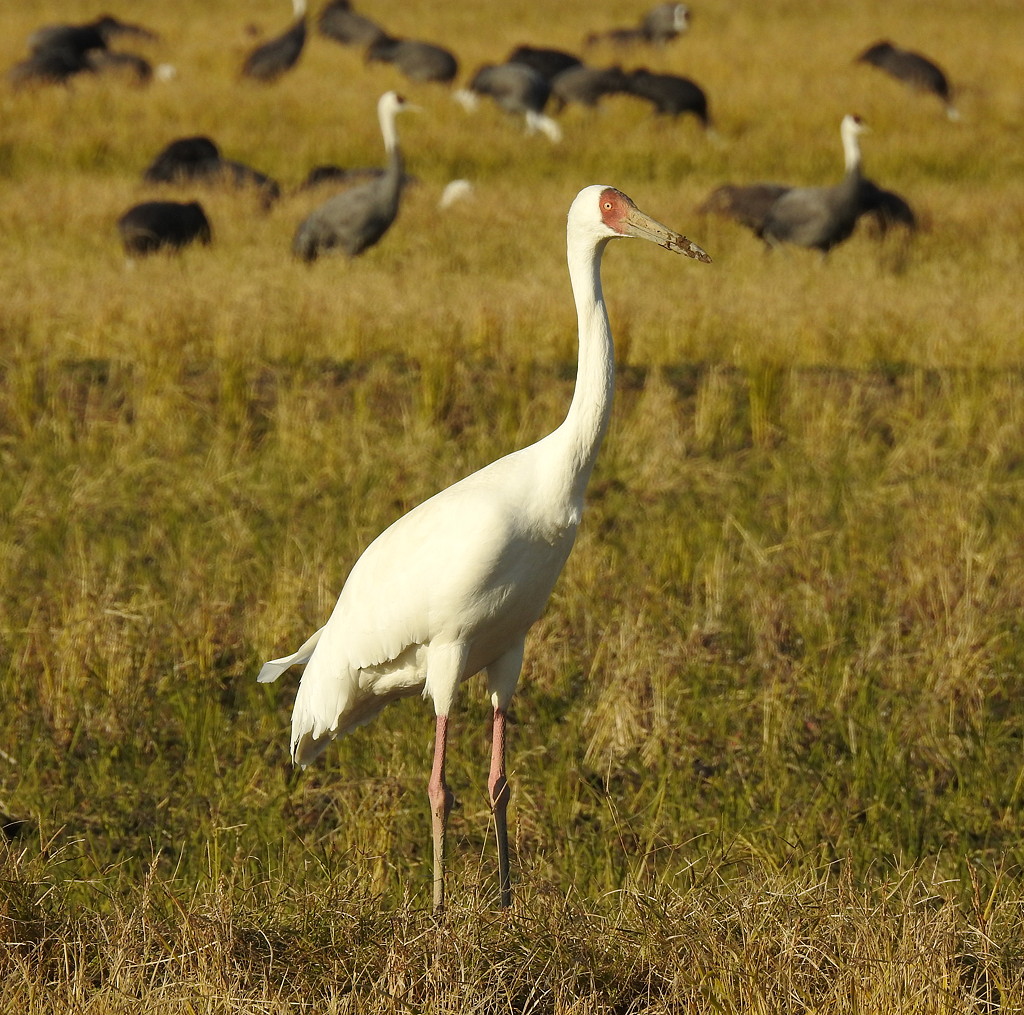
The adult Siberian Crane at Izumi in December 2021 © Mark Brazil
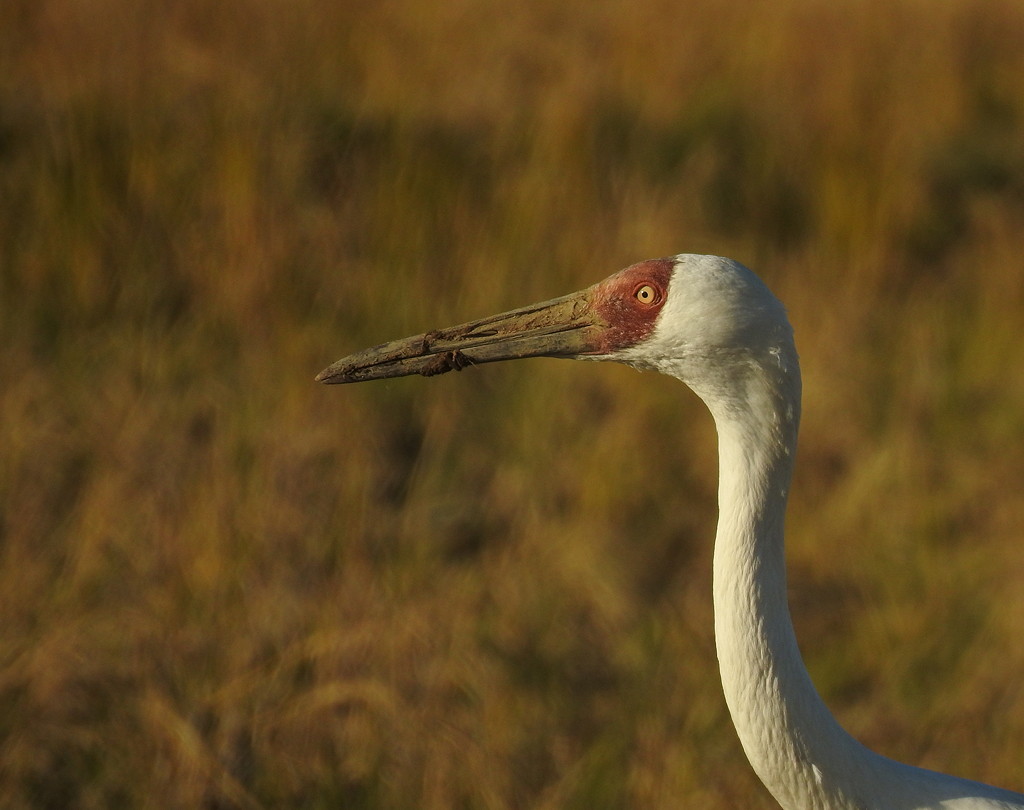
Siberian Crane portrait revealing its red forehead and yellow eye © Mark Brazil
A winter visit to Izumi can easily be combined with visits to other wetland sites along the shore of the Ariake Inland Sea, such as to Higashiyoka-higata in Saga Prefecture, or sites in Kumamoto Prefecture, or with visits to the Kirishima Volcanoes and Miike in Miyazaki Prefecture. There is no doubt that Kyūshū offers wonderful winter birding.
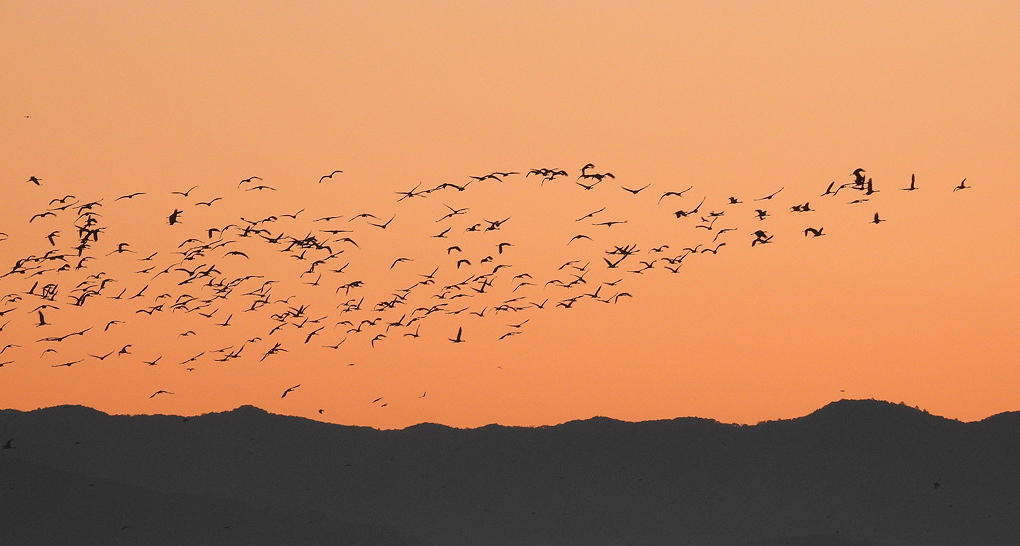
As the light fades, flocks of cranes return to roost © Mark Brazil
